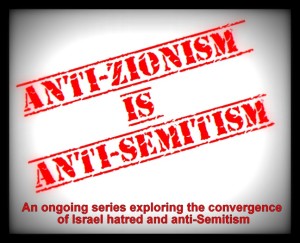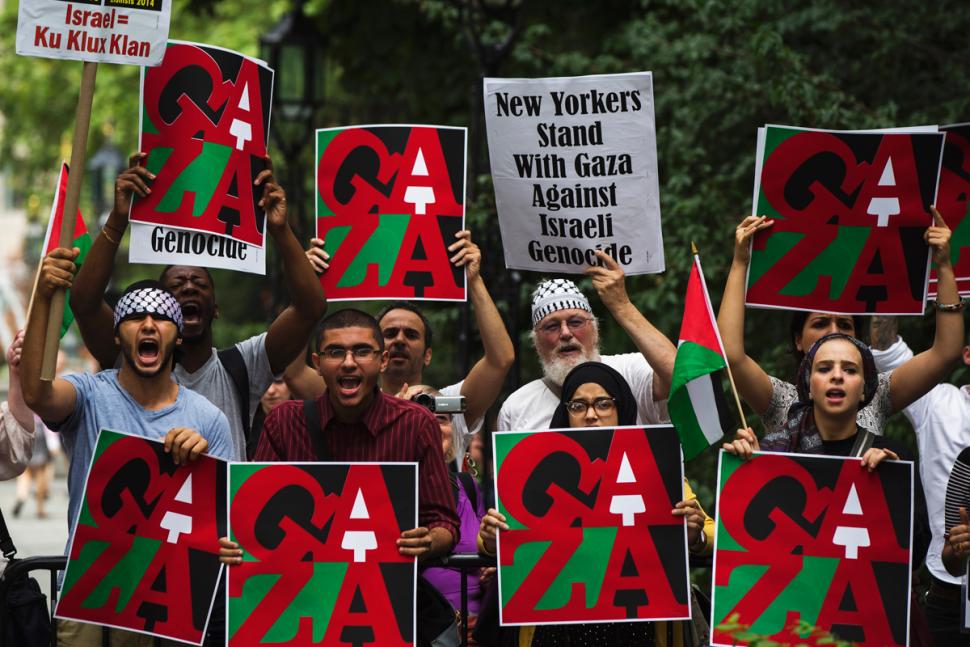The ‘New Antisemitism’
PALESTINE ISRAEL GAZA GENOCIDE, 5 Oct 2015
Antony Lerman – Open Democracy
 There are many Jews who actively sympathise with an anti-racist political vision. But the ‘new antisemitism’ complicates how the organised Jewish ‘community’ could identify with such an enterprise.
There are many Jews who actively sympathise with an anti-racist political vision. But the ‘new antisemitism’ complicates how the organised Jewish ‘community’ could identify with such an enterprise.
29 Sep 2015 – Assessing the complex political implications of the ‘new antisemitism’ in a short paper is quite a challenge. Inevitably, I must paint with a broad brush and, therefore, apologise for any loss of nuance as a result. It is also important that I make clear from the outset that I do not accept the validity of the concept of the ‘new antisemitism’, a term I will use in quotes throughout. Nevertheless, as this article is not about the validity or otherwise of the term, I will not enter into the arguments for and against the term itself.
Discussion about the ‘new antisemitism’ very often dwells on the bitter and extreme disagreement between many of those who accept that there is such a thing and many of those who fundamentally question the validity of the notion. Nevertheless, although this state of affairs exemplifies just how politicised practically all discussion around the question of the ‘new antisemitism’ has become, placing the extreme differences centre-stage often results in a failure to interrogate or understand fully the political, or for that matter the contemporary historical, context of the emergence of ‘new antisemitism’ thinking.
The term ‘new antisemitism’ is actually not very new and has been applied to a variety of rather different phenomena. But from the late 1970s onwards, the term was increasingly applied, somewhat loosely, to forms of criticism of – and hostility to – Israel, especially that which emanated from the Arab world.

Manifesting a new antisemitism? Protests in New York at support given by NY politicians for Israel during its 2014 attack on Gaza, July 2014. Photo by Lucas Jackson / Reuters
However, in the last few decades, and especially since the beginning of the twenty-first century, those who use the term to describe what they believe is an actually existing phenomenon have tended to identify with a far more specific understanding of what it means. Irwin Cotler, Canadian professor of law and former minister of justice in the 2003-2006 Liberal government, describes it in the following way:
“In a word, classical anti-Semitism is the discrimination against, denial of, or assault upon the rights of Jews to live as equal members of whatever society they inhabit. The new anti-Semitism involves the discrimination against, denial of, or assault upon the right of the Jewish people to live as an equal member of the family of nations, with Israel as the targeted ‘collective Jew among the nations’.”
This definition, which appeared in this particular formulation in the National Post on 9 November 2010, has been publicly proclaimed countless times by Cotler, one of the key figures involved in disseminating the term since the 1970s.
The ‘New Antisemitism’ and Anti-Zionism
The ‘new antisemitism’ is seen by most – but by no means all – of those who give it credence and promote its use as synonymous with anti-Zionism. As such, they find it not only in the Arab world but also in the political left, anti-globalisation movements, jihadist and Islamist movements as well as the Muslim world more generally, the Palestinian Solidarity Campaign, the left-liberal press, anti-racist groups – the list continues.
The “Working Definition of Antisemitism”, published by the now defunct EU Monitoring Center on Racism and Xenophobia (EUMC) in 2005, was central in providing the notion of the ‘new antisemitism’ with legitimacy and is taken by its proponents to be the European Union definition of antisemitism. This 514-word document contains a key passage giving examples of critical discourse about Israel that it says ‘could’ be seen as antisemitic.
One of the main drivers behind the formulation of the ‘new antisemitism’ idea was the passing, in 1975, of UN General Assembly resolution 3379 (revoked in 1991), which equated Zionism with racism. It is important to remember that, at the time, support for Zionism and Israel was still broadly seen as a progressive and liberal cause in the west. Quite a number of the African and non-aligned countries that voted for resolution 3379 had good, if fairly low-key relations with Israel, as a result of the efforts of Israel’s then socialist government to improve its international position.
So the apparent snub to Israel by these countries, and the perception among Jewish and non-Jewish supporters of Israel in the West that Israel was losing its status as a progressive cause, provoked much soul-searching and consternation. In Jewish and Israeli circles the dominant response was not to see any flaws in Zionism but rather in those attacking it and Israel. As a result, one of the main questions being asked was: What is the relationship between anti-Zionism and antisemitism?
While some writers, academics and commentators were convinced from early on that Arab hostility to Zionism and Israel was antisemitic, during the 1970s and 1980s there was considerable debate and reasoned disagreement about the validity of the charge. Political and ideological considerations played a relatively small part in the growing numbers of conferences and seminars taking place to discuss the issue.
But what began largely as a series of intellectual and academic discussions gradually changed character as pro-Israel advocacy groups, the World Zionist Organisation, multi-agenda major American Jewish organisations (such as the Anti-Defamation League and the American Jewish Committee) and Jewish communal organisations monitoring and combating antisemitism took up the matter. Mounting international criticism of Israel began to have a major impact on their work.
What started organically, therefore, morphed into a planned campaign to create a coalition of mostly Jewish activist academics, pro-Israel and national representative bodies in the Jewish diaspora and the aforementioned major American Jewish organisations to take the discussions in an increasingly political and ideological direction, linking anti-Zionism and antisemitism ever more closely.
A key player in – and growing influence on – this campaign was the Israeli government, which pursued a new policy from the late 1980s through the newly established Monitoring Forum on Antisemitism. The policy aimed to establish Israeli hegemony over the monitoring and combating of antisemitism by Jewish groups worldwide. This was coordinated and mostly implemented by Mossad representatives working out of Israeli embassies. The policy served to bind diaspora communities more closely to Israel, their self-appointed ‘defender against external threats’, to promote Zionist immigration by using highly problematic data on antisemitic manifestations to stress the fragility of diaspora Jewish communities, as well as to portray Israel as being equally in the firing line of antisemitic attack by increasingly linking any criticism of Israeli policy with antisemitism.
![Jewish march in solidarity with Gaza, NY City, July 24, 2014. Photo by Martyna Starosta, Forward [We have taken this photo from Islamique magazine which posted it with the caption “Jewish survivors and descendants of survivors and victims of Nazi genocide unequivocally condemn the massacre of Palestinians in Gaza”.]](https://www.transcend.org/tms/wp-content/uploads/2015/10/jews-for-palestine-700x325-israel-gaza.jpg)
Jewish march in solidarity with Gaza, NY City, July 24, 2014. Photo by Martyna Starosta, Forward [We have taken this photo from Islamique magazine which posted it with the caption “Jewish survivors and descendants of survivors and victims of Nazi genocide unequivocally condemn the massacre of Palestinians in Gaza”.]
However, at the start of the twenty-first century, deepening disillusionment about Oslo, as well as events such as the outbreak of the second intifada, the Durban UN Anti-Racism conference and 9/11, led many to conclude that ‘new antisemitism’ was rising exponentially, driven by perceived Muslim hatred of Jews expressed largely in the form of anti-Israel sentiment. This became the dominant narrative among Jewish and Israeli leaders and the wider, growing neo-conservative commentariat, which included prominent journalists and columnists, as well as prominent academics.
The Israeli government, reflecting the political drift to the far right in the country, again very publicly linked Israel’s fate with Jews worldwide and stepped up its leadership role on the antisemitism question. This time it had more cooperation from diaspora Jewish leaders, many of whom were more in sympathy with Israel’s harder line political direction than they had been when the country was under Rabin’s control. In these circles, the ‘new antisemitism’ discourse was now in the ascendant.
In practice, what this meant was that in discussion, debate and argument about the state of contemporary antisemitism, ‘new antisemitism’ thinking occupied centre-stage and was rapidly acquiring the status of a new orthodoxy. This was not only in political forums, the media and public debates, but also in academic conferences, seminars, academic articles and books.
Inevitably, being so intimately connected to a controversial political issue – the Israel-Palestine conflict – discussion of the issue of antisemitism became more politicised than ever before. Virtually no discussion of the phenomenon could take place without Israel and Zionism being centre-stage. And hardly any discussion about the Israel-Palestine conflict could take place without reference to the ‘new antisemitism’.
There have always been disagreements about the definition and use of the word antisemitism, but during the first three or four decades after the Second World War there was, broadly speaking, a common understanding of what constituted antisemitism. This linked it to the classical stereotyped images of ‘the Jew’ forged in Christendom, adopted and adapted by antisemitic political groups in the nineteenth century and further developed by race-theorists and the Nazis in the twentieth century. That process of reformulation and revision did not end with the Holocaust. The most significant development in antisemitism after 1945 was the rapid emergence of Holocaust denial.
Interestingly, while it seems that some referred to this as ‘new antisemitism’, most researchers and academics analysing and writing about the phenomenon had no difficulty in seeing it as essentially a new manifestation of a consensually defined antisemitism. But by the early to mid-2000s, the consensus had broken down.
The Irresistible Rise of ‘New Antisemitism’ Discourse
The acceptance of ‘new antisemitism’ thinking means that antisemitism has been fundamentally redefined, so that a discourse about Israel and Zionism can be labelled antisemitic even though it contains none of the classic stereotypes of ‘the Jew’ that were previously widely understood to be essential to expressions of the phenomenon.
In addition, in the writings of many of the ‘new antisemitism’ theorists and propagandists, as well as in political and communal support for some Jewish communal leaders, columnists and clergy, there is a confrontational and racialised approach towards Muslims and Islam. It is not only Jihadists and Islamists who are seen as responsible for the ‘new antisemitism’, but also the collective mindset of the ‘Muslim community’ and the ‘unreformed’ nature of Islam as a religion.
The ‘collective Jew among the nations’ definition of ‘new antisemitism’ licenses this approach, which represents a form of stereotyping of the Other that is incompatible with the consensual understanding of antisemitism that has been fractured and undermined by ‘new antisemitism’. It is also the case that, since international bodies like the UN, human rights and humanitarian relief organisations, the EU, some churches and the ‘left’ are seen as responsible for disseminating ‘new antisemitism’, despite long-standing traditions of Jewish support for social justice, many Jewish communal leaders and commentators have distanced themselves from the promotion of human rights and anti-racism.
Although the concept of ‘new antisemitism’ emerged from serious discussions about the relationship between antisemitism and anti-Zionism, its ubiquity by the mid-2000s was a direct result of a concerted campaign to get individual governments, parliamentary bodies, the Organisation for Security and Cooperation in Europe, the Council of Europe and others to accept the validity of the notion.
Despite the fact that significant proportions of diaspora Jewish opinion distanced itself from Israel in recent years, this campaign resulted from a much closer nexus between Jewish communal leaderships, national and international Jewish organisations, pro-Israel advocacy groups, institutional arms of the Israeli government and academics and researchers promoting the idea of the ‘new antisemitism’.
The ongoing confrontation between proponents and opponents of the EUMC’s “Working Definition of Antisemitism”, irrespective of the fact that the EUMC’s successor organisation, the Fundamental Rights Agency, has now abandoned it, is a major example of this. It is perhaps expressed most sharply in the recent case brought against the University and Colleges Union in the UK by Ronnie Fraser, backed by Anthony Julius and the law firm Mishcon de Rea, which Fraser and Julius comprehensively lost. Supporters of Fraser have spun the result as, in effect, an antisemitic conspiracy between the Tribunal panel and the UCU.
The de-coupling of the understanding of antisemitism from traditional antisemitic tropes, which thereby made criticism of Israel in and of itself antisemitic, necessarily made the opposite – support for Israel – into a touchstone for expressing sympathy with Jews. This opened the door to the phenomenon of Jewish support for far right, anti-Islam, anti-immigrant parties keen to whitewash their pasts and sanitise their anti-Muslim prejudice by expressing support for Israel and seeing the country and its Jews as the front line against Islam’s ‘incursion into Europe’.
It is not surprising, therefore, that acceptance of the ‘new antisemitism’ theory has contributed to the exacerbation of tensions between Muslims and Jews in the UK (and elsewhere in Europe). There is, however, mutual pre-existing misunderstanding and mistrust, while negative images of Jews unrelated to the Israel-Palestine conflict are common among some Muslims.
The scale of the problem from the Jewish side can be gauged from the results of the EU Fundamental Rights Agency-commissioned survey of Jewish opinion on antisemitism in eight European countries, which was devised, managed and analysed by JPR and released on 9 November 2013. This shows a marked tendency to blame Muslim populations in Europe for the perceived worsening of the antisemitic climate. It is interesting to note that these results were released on Kristallnacht commemoration day. This was no coincidence, but rather another example of the inextricable link between research on and politics of antisemitism and the battle to control historical memory.
When considering how to neutralise and reverse the impact of ‘new antisemitism’ thinking within the Jewish community, the problem is made more acute by the fact that the discourse employed by the proponents of the concept shows remarkable similarities with antisemitic discourse itself, especially in its demonisation of Jews who question the validity of the concept. One example is the attack by more than 20 ‘new antisemitism’ proponents, orchestrated by Clemens Heni of the self-styled Berlin International Centre for the Study of Antisemitism, on Brian Klug when he was invited to deliver an address on antisemitism at the Berlin Jewish Museum’s 2013 Kristallnacht commemoration event.
When this occurs at the same time as prominent Jewish figures, aided and abetted by significant commentators, academics and politicians – some Jewish, some not – who are constructing and legitimising anti-Muslim racism, we are faced with a community almost presenting an image of itself as under siege at a time when the position of Jews in British society has never been so good, objectively speaking.
My pessimistic conclusion is that although there are still very many Jews who would actively sympathise with the aim of building an anti-racist political vision, the influence of ‘new antisemitism’ thinking, among other factors, makes it very difficult to see how what we understand as the organised Jewish ‘community’ could be persuaded to identify with such an enterprise.
________________________________
Antony Lerman is an Honorary Fellow at the Parkes Institute for the Study of Jewish/non-Jewish Relations, Southampton University. He is also a member of the Black-Jewish Forum, a member of the Advisory Committee of the Holocaust Exhibition at the Imperial War Museum and a founding member of the Jewish Forum for Justice and Human Rights and the Independent Jewish Voices steering group. He is a JfJfP signatory. He is the author of The Making and Unmaking of a Zionist: A Personal and Political Journey (Pluto Press 2012). He tweets @tonylerman.
This article is published under a Creative Commons Attribution-NonCommercial 4.0 International licence. If you have any queries about republishing please contact us. Please check individual images for licensing details.
Go to Original – opendemocracy.net
Join the BDS-BOYCOTT, DIVESTMENT, SANCTIONS campaign to protest the Israeli barbaric siege of Gaza, illegal occupation of the Palestine nation’s territory, the apartheid wall, its inhuman and degrading treatment of the Palestinian people, and the more than 7,000 Palestinian men, women, elderly and children arbitrarily locked up in Israeli prisons.
DON’T BUY PRODUCTS WHOSE BARCODE STARTS WITH 729, which indicates that it is produced in Israel. DO YOUR PART! MAKE A DIFFERENCE!
7 2 9: BOYCOTT FOR JUSTICE!
DISCLAIMER: The statements, views and opinions expressed in pieces republished here are solely those of the authors and do not necessarily represent those of TMS. In accordance with title 17 U.S.C. section 107, this material is distributed without profit to those who have expressed a prior interest in receiving the included information for research and educational purposes. TMS has no affiliation whatsoever with the originator of this article nor is TMS endorsed or sponsored by the originator. “GO TO ORIGINAL” links are provided as a convenience to our readers and allow for verification of authenticity. However, as originating pages are often updated by their originating host sites, the versions posted may not match the versions our readers view when clicking the “GO TO ORIGINAL” links. This site contains copyrighted material the use of which has not always been specifically authorized by the copyright owner. We are making such material available in our efforts to advance understanding of environmental, political, human rights, economic, democracy, scientific, and social justice issues, etc. We believe this constitutes a ‘fair use’ of any such copyrighted material as provided for in section 107 of the US Copyright Law. In accordance with Title 17 U.S.C. Section 107, the material on this site is distributed without profit to those who have expressed a prior interest in receiving the included information for research and educational purposes. For more information go to: http://www.law.cornell.edu/uscode/17/107.shtml. If you wish to use copyrighted material from this site for purposes of your own that go beyond ‘fair use’, you must obtain permission from the copyright owner.
One Response to “The ‘New Antisemitism’”
Read more
Click here to go to the current weekly digest or pick another article:
PALESTINE ISRAEL GAZA GENOCIDE:


Thank you for publishing this report on manufacturing “New antisemitism” by the ultimate Insider. Buy the book – read it – recommend it.
A positive point: the JPR has learned a lot from Antony Lerman and their publications on antisemitism still are fairly readable.
Have a look at
http://www.jpr.org.uk/documents/JPR.2015.Policy_Debate_-_Contemporary_Antisemitism.pdf (at least page 3)
– There is NO proof of an upward trend
– Variations between years are caused by Israeli Wars against Gaza
– The – The New antisemitism craze is fabricated by the Mossad
and propagated by Your Israeli embassy (as Antony Lerman explains).
Werner T. Meyer